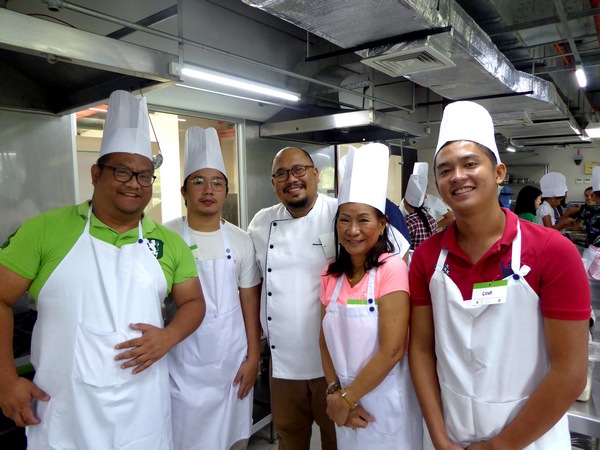
Sugba Group with Chef Tatung (center)
EVERY time we dine out, my friend Tensie Villa makes sure that no food goes to waste. So she takes home whatever we fail to consume, to feed hungry children she meets in the streets.
Tensie teaches in Montessori schools for the children of the dumpsite so she is acutely aware of hungry children.
This is just one of the many challenges we face.
Steamed Shrimps
The WWF (World Wide Fund for Nature) brought to Cebu, in partnership with International Culinary Arts Academy of Cebu (ICAAC) the second leg of the Savour Planet Series with the topic “Cooking with a Purpose” to empower and educate Filipino Diners on the importance of sustainable food systems and sustainable dining.
The WWF Philippine Project Manager for Sustainable Concepts and Production (SCP) opened the session and shared some of the staggering facts: 2.3 million of our 103 million populations are hungry; we waste rice enough to feed 4.3 million Filipinos.
Habits passed on to us have always been unknowingly rooted in sustainability, such as “Finish what is on your plate,” “Eat every grain of rice,” “Eat vegetables and fish.”
Avoiding food waste, eating local produce and going for healthier dishes are childhood lessons we grew up with and all of these are related to food sustainability.
Together with ICAAC and its Dean/Chef Jeremy Young and Chef Tatung Sarthou, the WWF conducted “Kaon na ta” workshop at ICAAC. Chef Jeremy discussed the importance of promoting the concept of sustainable dining stating that appreciation for local cuisine and ability to craft dishes that allow ingredients to shine and should be taught in the next generation of culinary and restaurant professionals while Chef Tatung shared his observation that “we got so hung up on techniques and prestige in keeping up with global trends that have made food very complicated”.
He claims it is time to correct this and go back to basics. This kept me and many of us musing on Chef Tatung’s statement over a delicious Breakfast Vegetable Muffins and Croque Madame sandwiches.
We were divided into groups and were given our cooking assignments based on the Cebuano cuisine concept of “Sutukil” (sugba, tuwa, kilaw). The “farm to table” concept is best observed but due to lack of time, ingredients were bought fresh from Carbon market.
There were four of us in the “Sugba” group.
I was a bit disappointed with the dishes since I was looking forward to a more exciting cooking technique.
But the use of local ingredients was essential in he sustainability of the cuisine.
We had pork belly and squid.
The slices of pork belly were simply salted while we were given achuete oil for the squid, to give it a nice yellow-orange color.
The slices of pork belly and skewered squid were grilled over live charcoal embers.
The key to good grilling is not to overdo lest the meats get tough. The other groups were tasked to prepare the “Kinilaw” using tanguigue as well as seaweed (guso) salad. Other groups prepared Ginataang Manok using coconut milk and Pinais or Kitong fish stuffed with onions, tomatoes, ginger wrapped in banana leaves and grilled.
Sustainability in dining means using what is available, what is local and what is in season. I threw a question to Chef Jeremy Young: What happens to haute cuisine?.
Hope fully, another Savour Planet Workshop will address this.